Optimization of Hybrid Energy Storage Systems at the Building Level with Combined Heat and Power Generation
Abstract
:1. Introduction
2. System Definition
3. HESS Optimization
3.1. Battery System Optimization
3.1.1. Optimization Function for Battery System
3.1.2. Constraints
3.2. Supercapacitor System Optimization
4. System Control Strategy
4.1. Electricity System Control Strategy
4.1.1. Electricity System Control Strategy for H1 and H2
4.1.2. Electricity System Control Strategy for L1 and L2
4.1.3. Electricity System Control Strategy for L3
4.2. Heat System Control Strategy
5. Results
5.1. Battery System Optimization
5.2. Average Daily HESS Cost
6. Discussion
6.1. Capacity Saturation
6.2. SOC Saturation
6.3. Discharge Current Saturation
7. Conclusions
Acknowledgments
Author Contributions
Conflicts of Interest
References
- Mishra, A.; Irwin, D.; Shenoy, P.; Kurose, J.; Ting, Z. GreenCharge: Managing RenewableEnergy in Smart Buildings. IEEE J. Sel. Areas Commun. 2013, 31, 1281–1293. [Google Scholar] [CrossRef]
- Le Blond, S.; Li, R.; Li, F.; Wang, Z. Cost and Emission Savings from the Deployment of Variable Electricity Tariffs and advanced Domestic Energy Hub Storage Management. In Proceedings of the PES General Meeting|Conference & Exposition, National Harbor, MD, USA, 27–31 July 2014; pp. 1–5. [Google Scholar]
- UK Government. The Carbon Plan, Department of Energy and Climate Change. Available online: https://www.gov.uk/government/uploads/system/uploads/attachment_data/file/47613/3702-the-carbon-plan-delivering-our-low-carbon-future.pdf (accessed on 26 April 2017).
- Leadbetter, J.; Swan, L. Battery storage system for residential electricity peak demand shaving. Energy Build. 2012, 55, 685–692. [Google Scholar] [CrossRef]
- Agamah, S.; Ekonomou, L. Peak demand shaving and load-levelling using a combination of bin packing and subset sum algorithms for electrical energy storage system scheduling. IET Sci. Meas. Technol. 2016, 10, 477–484. [Google Scholar] [CrossRef]
- Balcombe, P.; Rigby, D.; Azapagic, A. Environmental impacts of microgeneration: Integrating solar PV, Stirling engine CHP and battery storage. Appl. Energy 2015, 139, 245–259. [Google Scholar] [CrossRef]
- Dufo-López, R.; Bernal-Agustín, J.L.; Yusta-Loyo, J.M.; Domínguez-Navarro, J.A.; Ramírez-Rosado, I.J.; Lujano, J.; Aso, J. Multi-objective optimization minimizing cost and life cycle emissions of stand-alone PV–wind–diesel systems with batteries storage. Appl. Energy 2011, 88, 4033–4041. [Google Scholar] [CrossRef]
- McManus, M.C. Environmental consequences of the use of batteries in low carbon systems: The impact of battery production. Appl. Energy 2012, 93, 288–295. [Google Scholar] [CrossRef]
- Kollimalla, S.K.; Mishra, M.K.; Narasamma, N.L. Design and Analysis of Novel Control Strategy for Battery and Supercapacitor Storage System. IEEE Trans. Sustain. Energy 2014, 5, 1137–1144. [Google Scholar] [CrossRef]
- Tianpei, Z.; Wei, S. Optimization of Battery-Supercapacitor Hybrid Energy Storage Station in Wind/Solar Generation System. IEEE Trans. Sustain. Energy 2014, 5, 408–415. [Google Scholar]
- Jenkins, D.P.; Fletcher, J.; Kane, D. Lifetime prediction and sizing of lead-acid batteries for microgeneration storage applications. IET Renew. Power Gener. 2008, 2, 191–200. [Google Scholar] [CrossRef]
- Bo, Z.; Xuesong, Z.; Jian, C.; Caisheng, W.; Li, G. Operation Optimization of Standalone Microgrids Considering Lifetime Characteristics of Battery Energy Storage System. IEEE Trans. Sustain. Energy 2013, 4, 934–943. [Google Scholar]
- Benini, L.; Bruni, D.; Mach, A.; Macii, E.; Poncino, M. Discharge current steering for battery lifetime optimization. IEEE Trans. Comput. 2003, 52, 985–995. [Google Scholar] [CrossRef]
- Papic, I. Simulation model for discharging a lead-acid battery energy storage system for load leveling. IEEE Trans. Energy Convers. 2006, 21, 608–615. [Google Scholar] [CrossRef]
- Hoxie, E.A. Some discharge characteristics of lead acid batteries. Trans. Am. Inst. Electr. Eng. Part II Appl. Ind. 1954, 73, 17–22. [Google Scholar] [CrossRef]
- Power-Sonic. Sealed Lead-Acid Batteries Technical Manual. Available online: http://www.power-sonic.co.uk/files/DA035%20-%20technical%20Manual%20(USA).pdf (accessed on 26 April 2017).
- Shuo, T.; Munan, H.; Minggao, O. An Experimental Study and Nonlinear Modeling of Discharge I–V Behavior of Valve-Regulated Lead–Acid Batteries. IEEE Trans. Energy Convers. 2009, 24, 452–458. [Google Scholar] [CrossRef]
- Gee, A.M.; Robinson, F.V.P.; Dunn, R.W. Analysis of Battery Lifetime Extension in a Small-Scale Wind-Energy System Using Supercapacitors. IEEE Trans. Energy Convers. 2013, 28, 24–33. [Google Scholar] [CrossRef]
- Linzen, D.; Buller, S.; Karden, E.; de Doncker, R.W. Analysis and evaluation of charge-balancing circuits on performance, reliability, and lifetime of supercapacitor systems. IEEE Trans. Ind. Appl. 2005, 41, 1135–1141. [Google Scholar] [CrossRef]
- Yonghua, C. Assessments of Energy Capacity and Energy Losses of Supercapacitors in Fast Charging Discharging Cycles. IEEE Trans. Energy Convers. 2010, 25, 253–261. [Google Scholar] [CrossRef]
- Richardson, M.T.I.; Infield, D.; Clifford, C. Domestic electricity use: A high-resolution energy demand model. Energy Build. 2010, 42, 1878–1887. [Google Scholar] [CrossRef]
- Steemers, R.Y.A.K. A method of formulating energy load profile for domestic buildings in the UK. Energy Build. 2005, 37, 663–671. [Google Scholar]
- Zhimin, W.; Chenghong, G.; Furong, L.; Bale, P.; Hongbin, S. Active Demand Response Using Shared Energy Storage for Household Energy Management. IEEE Trans. Smart Grid 2013, 4, 1888–1897. [Google Scholar]
- Carlon, E.; Schwarz, M.; Golicza, L.; Verma, V.K.; Prada, A.; Baratieri, M.; Haslinger, W.; Schmidl, C. Efficiency and operational behaviour of small-scale pellet boilers installed in residential buildings. Appl. Energy 2015, 155, 854–865. [Google Scholar] [CrossRef]
- Sheikhi, A.; Ranjbar, A.M.; Oraee, H. Financial analysis and optimal size and operation for a multicarrier energy system. Energy Build. 2012, 48, 71–78. [Google Scholar] [CrossRef]
- Panasonic. Lead Acid Batteries Technical Handbook. Available online: http://www.docin.com/p-1468343866.html (accessed on 26 April 2017).
- Maxwell. Maxwell Technologies BOOSTCAP Ultracapactior Cell Sizing, Rev 3. Available online: http://www.datasheetarchive.com/dl/Datasheet-095/DSA00114140.pdf (accessed on 17 February 2009).
- Lund, H.; Moller, B.; Mathiesen, B.V.; Dyrelund, A. The role of district heating in future renewable energy systems. Energy 2010, 35, 1381–1390. [Google Scholar] [CrossRef]
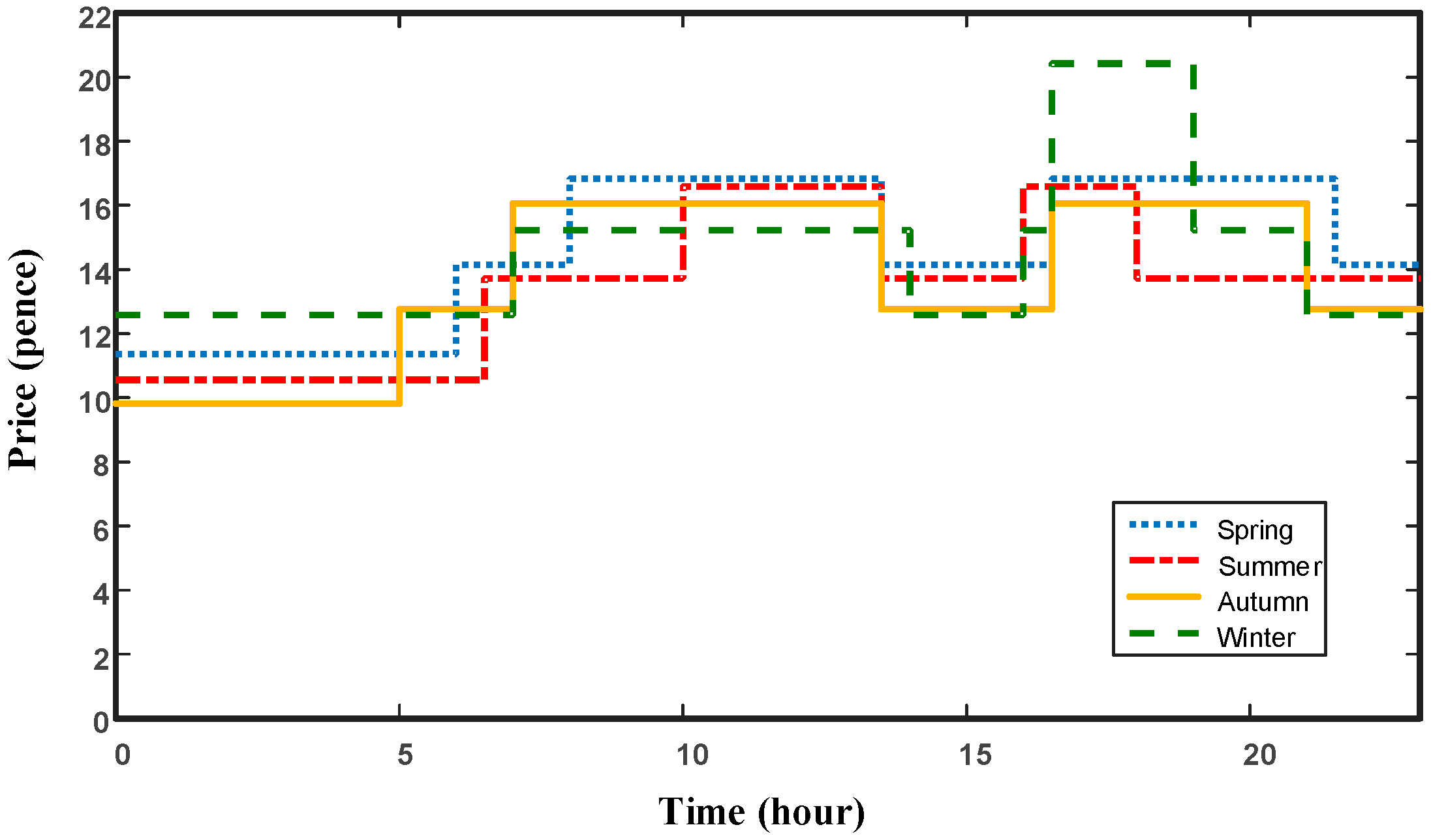
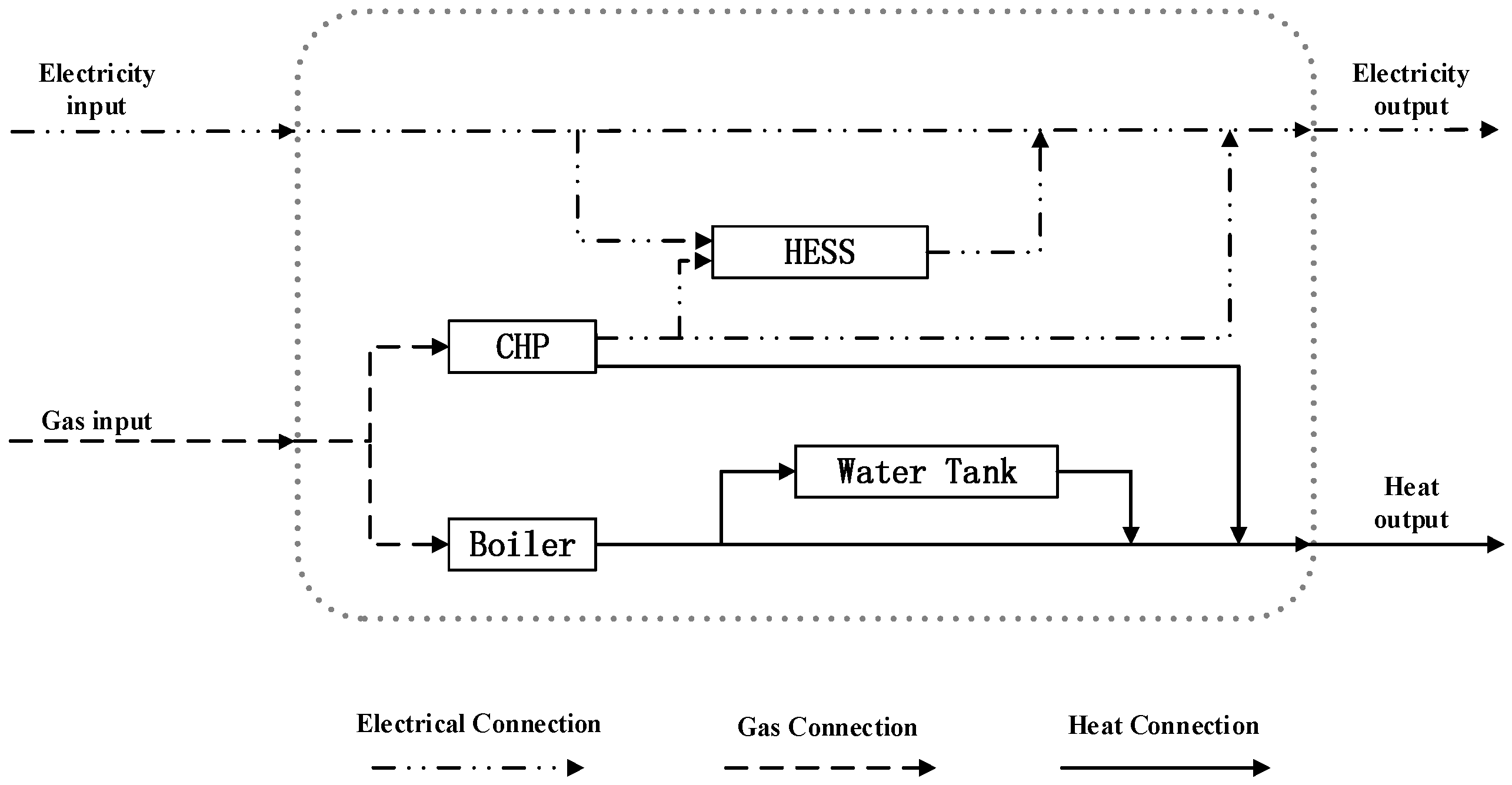
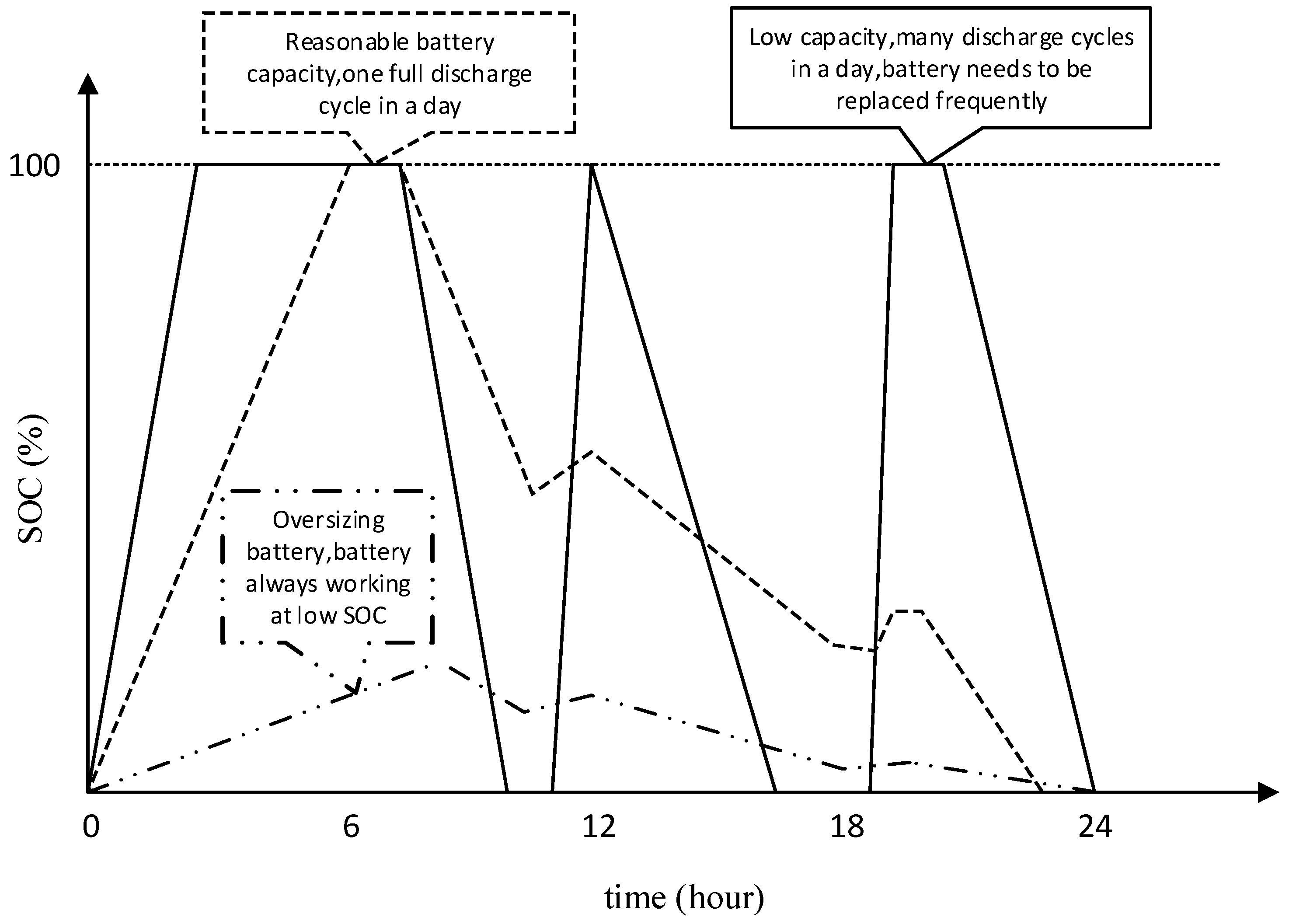
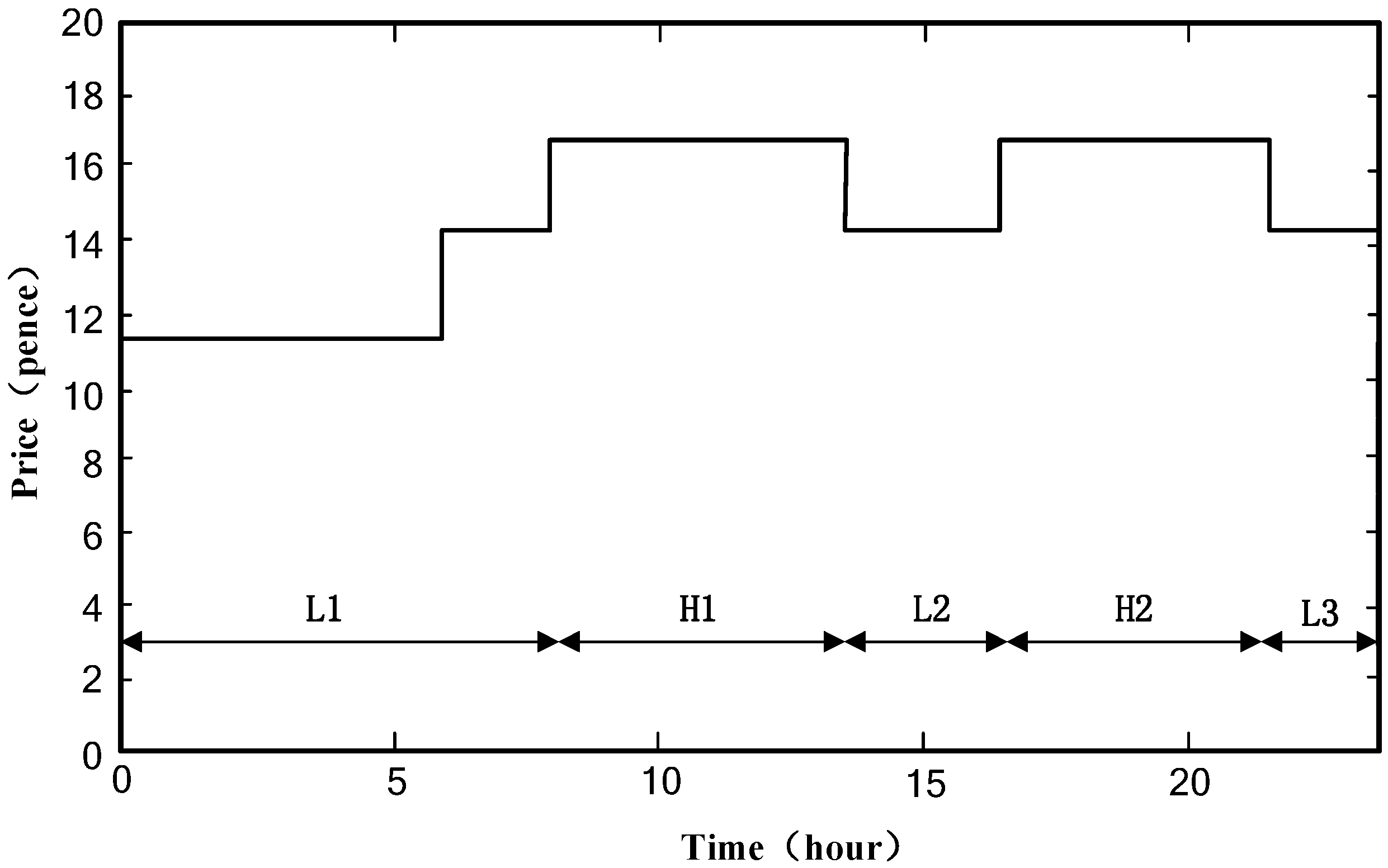

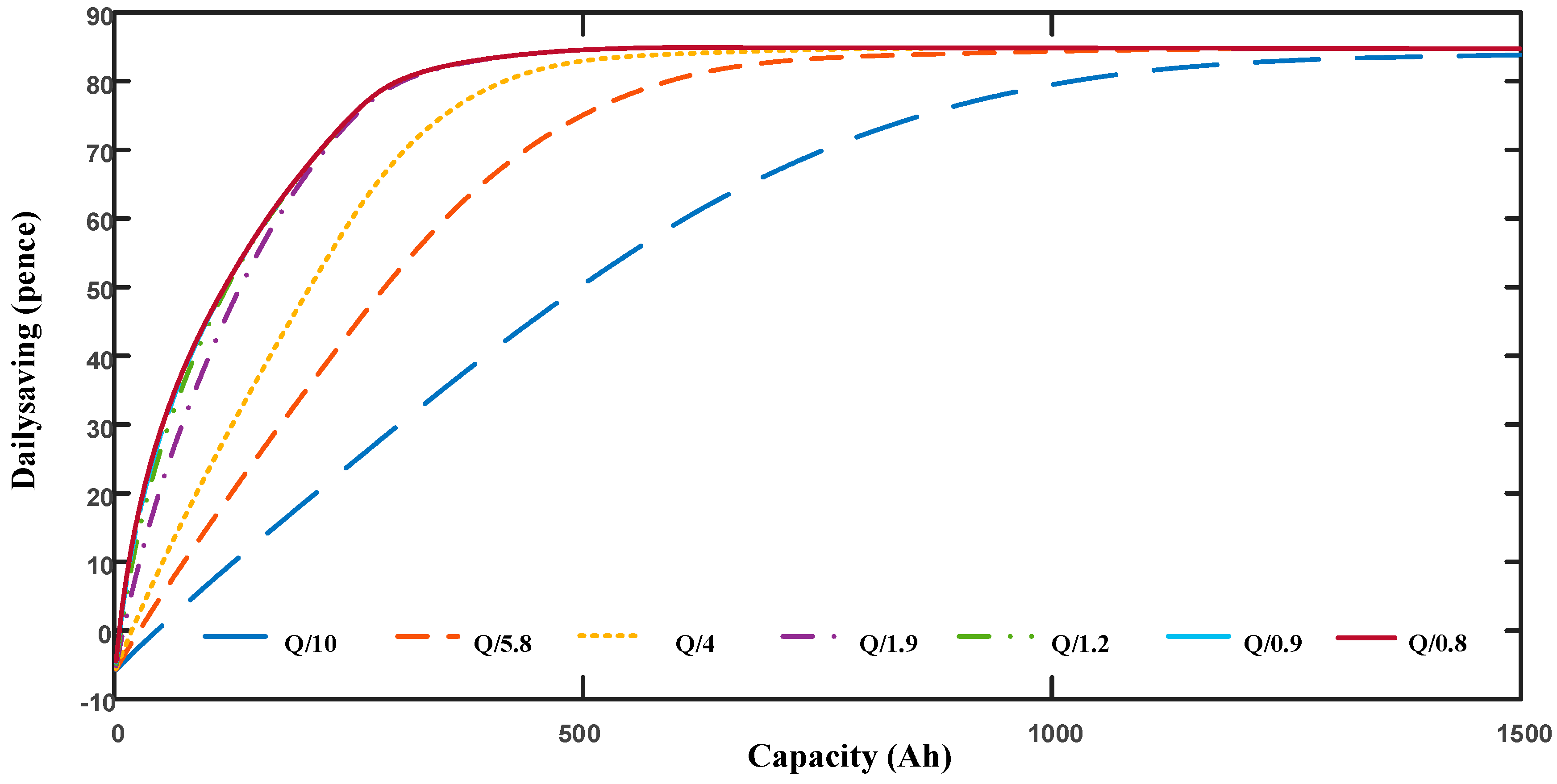
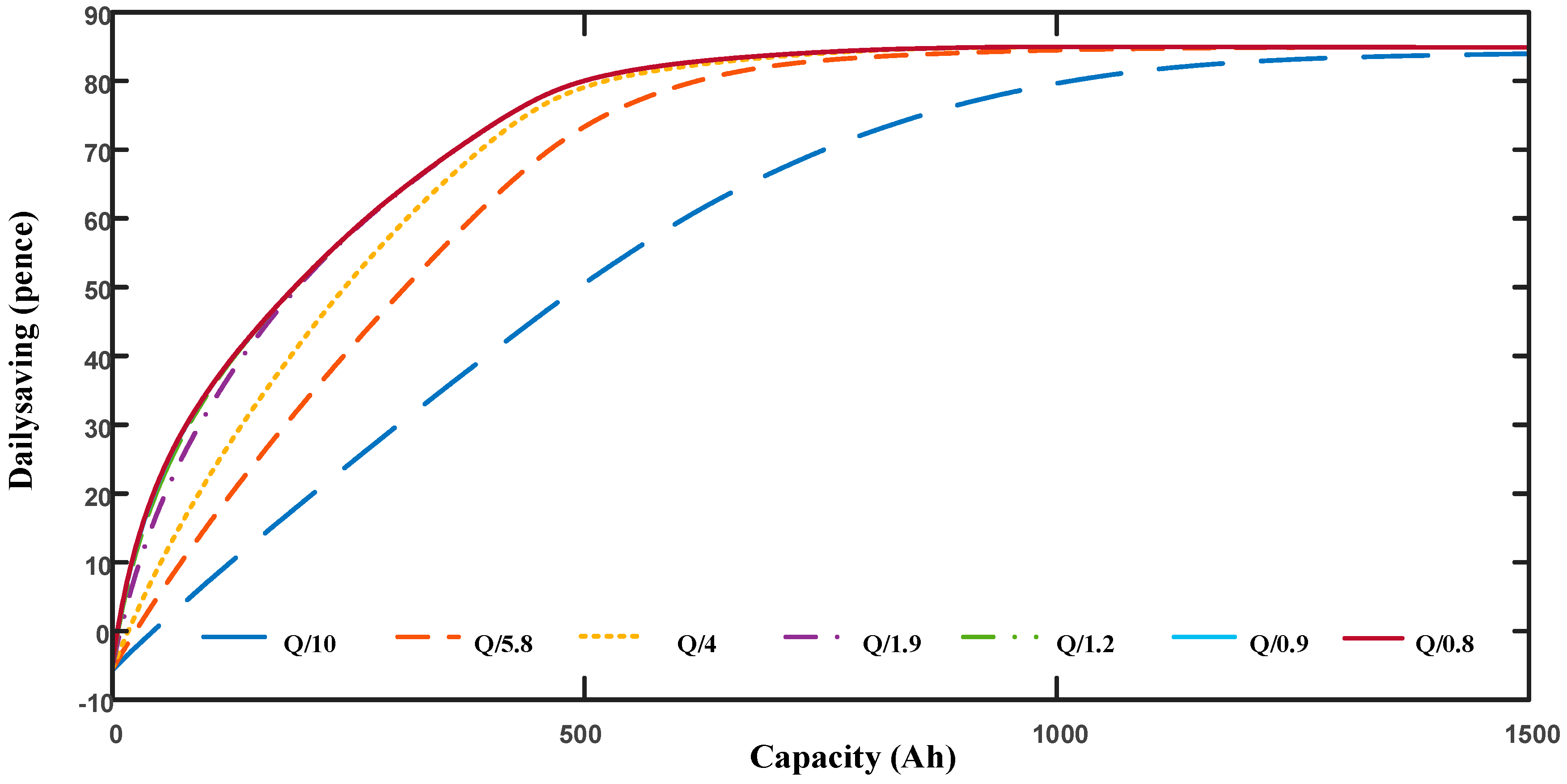
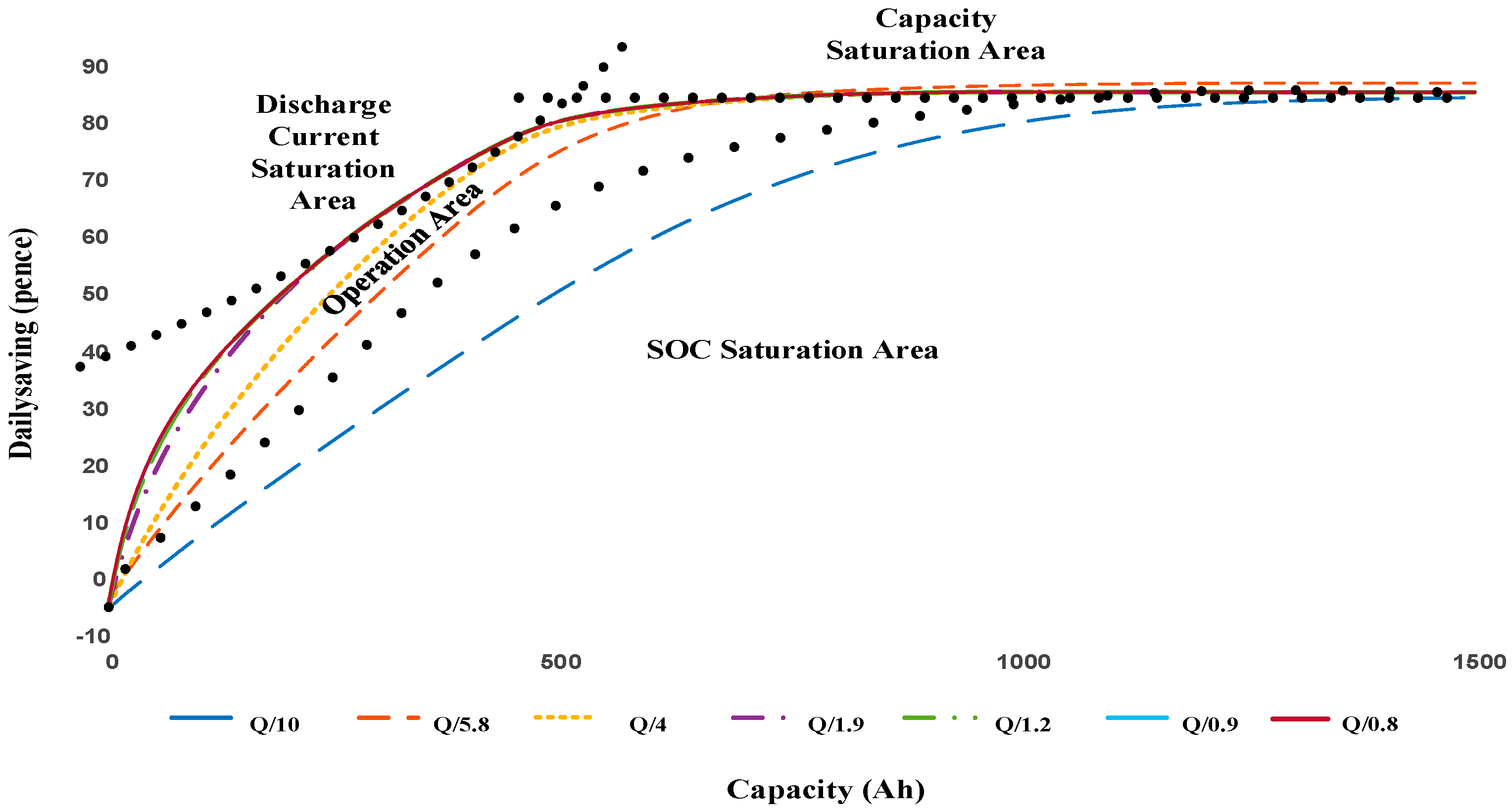
| Parameters | Value |
|---|---|
| UK domestic gas price | 5 pence/kWh |
| Boiler gas to heat efficiency | 88% |
| Rated power of CHP | 3 kW |
| CHP heat efficiency | 66% |
| CHP electricity efficiency | 22% |
| Overall efficiency of the battery | 80% |
| Overall efficiency of the supercapacitor | 98% |
| Overall efficiency of the supercapacitor | 98% |
| Overall efficiency of the water tank | 70% |
| Standby loss of the battery | 2% per month |
| Standby loss of the water tank | 25% per day |
| Standby loss of the supercapacitor | 0 |
| Time Period | State of CHP | Possible State of HESS | Electricity Supplier’s Priority List | |
|---|---|---|---|---|
| L1 | ON | Charge/Standby | 1. CHP 2. Grid | |
| H1 | ON | Charge/Discharge/Standby | 1. CHP 2.HESS 3. Grid | |
| L2 | ON | Charge/Standby | 1. CHP 2. Grid | |
| H2 | ON | Charge/Discharge/Standby | 1. CHP 2.HESS 3. Grid | |
| L3 | Start to Last 40 min of L3 | ON | Charge/Discharge/Standby | 1. CHP 2.HESS 3. Grid |
| ELast 40 min of L3 | OFF | Discharge/Standby | 1. HESS 2. Grid | |
| Discharge Current (A) | Q/10 | Q/5.8 | Q/4 | Q/1.9 | Q/1.2 | Q/0.9 | Q/0.8 |
|---|---|---|---|---|---|---|---|
| Average Daily Energy Saving (£) | 0.8 | 0.8 | 0.8 | 0.8 | 0.8 | 0.8 | 0.8 |
| Effective Battery Capacity (Ah) | 1022 | 624 | 527 | 504 | 504 | 504 | 504 |
| Installation Battery Capacity (Ah) | 1022 | 726 | 703 | 969 | 1229 | 1400 | 1626 |
| Average Daily Cost of Battery System (£) | 9.29 | 6.83 | 6.86 | 9.54 | 12.10 | 13.78 | 16.00 |
| Supercapacitor Capacity (F) | 137 | 144 | 176 | 355 | 562 | 749 | 843 |
| Average Daily Cost of Supercapacitor (£) | 0.05 | 0.06 | 0.07 | 0.14 | 0.23 | 0.30 | 0.34 |
| Average Daily Cost of HESS (£) | 9.34 | 6.89 | 6.93 | 9.68 | 12.33 | 14.08 | 16.34 |
| SOC (%) | 0 | 50 | 70 |
|---|---|---|---|
| Average Daily Energy Saving (£) | 0.8 | 0.8 | 0.8 |
| Best Discharge Current (A) | Q/1.9 | Q/4 | Q/5.8 |
| Effective Battery Capacity (Ah) | 199 | 416 | 624 |
| Installation Battery Capacity (Ah) | 382.7 | 555 | 726 |
| Average Daily Cost of Battery System (£) | 18.25 | 15.12 | 6.83 |
| Supercapacitor Capacity (F) | 141 | 136 | 144 |
| Average Daily Cost of Supercapacitor (£) | 0.26 | 0.15 | 0.06 |
| Average Daily Cost of HESS (£) | 18.51 | 15.27 | 6.89 |
© 2017 by the authors. Licensee MDPI, Basel, Switzerland. This article is an open access article distributed under the terms and conditions of the Creative Commons Attribution (CC BY) license (http://creativecommons.org/licenses/by/4.0/).
Share and Cite
Yu, D.; Liu, H.; Yan, G.; Jiang, J.; Le Blond, S. Optimization of Hybrid Energy Storage Systems at the Building Level with Combined Heat and Power Generation. Energies 2017, 10, 606. https://doi.org/10.3390/en10050606
Yu D, Liu H, Yan G, Jiang J, Le Blond S. Optimization of Hybrid Energy Storage Systems at the Building Level with Combined Heat and Power Generation. Energies. 2017; 10(5):606. https://doi.org/10.3390/en10050606
Chicago/Turabian StyleYu, Dongmin, Huanan Liu, Gangui Yan, Jing Jiang, and Simon Le Blond. 2017. "Optimization of Hybrid Energy Storage Systems at the Building Level with Combined Heat and Power Generation" Energies 10, no. 5: 606. https://doi.org/10.3390/en10050606






